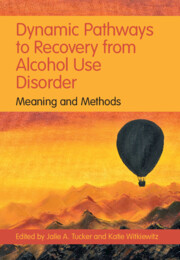Book contents
- Dynamic Pathways to Recovery from Alcohol Use Disorder
- Dynamic Pathways to Recovery from Alcohol Use Disorder
- Copyright page
- Dedication
- Contents
- Figures
- Tables
- Contributors
- Foreword
- Preface
- Acknowledgments
- Introduction
- Part I Micro Level
- Part II Meso Level
- Part III Macro Level
- 16 Recovery Communities
- 17 Disparities in Alcohol Treatment Access in Rural Areas
- 18 Recovery, Communities, and the Organized Recovery Movement
- 19 Alcohol Control Policy and Regulations to Promote Recovery from Alcohol Use Disorder
- 20 Causal Inference Approaches to Studying Recovery from Alcohol Use Disorder
- 21 Building on Collaborative Research to Co-Design SURE Recovery, a Mobile Application for People with Experience of Alcohol and Other Drug Problems
- 22 Economic Methods Used to Evaluate Recovery Programs for Alcohol Use Disorder
- Conclusions and Future Directions
- Index
- References
19 - Alcohol Control Policy and Regulations to Promote Recovery from Alcohol Use Disorder
from Part III - Macro Level
Published online by Cambridge University Press: 23 December 2021
- Dynamic Pathways to Recovery from Alcohol Use Disorder
- Dynamic Pathways to Recovery from Alcohol Use Disorder
- Copyright page
- Dedication
- Contents
- Figures
- Tables
- Contributors
- Foreword
- Preface
- Acknowledgments
- Introduction
- Part I Micro Level
- Part II Meso Level
- Part III Macro Level
- 16 Recovery Communities
- 17 Disparities in Alcohol Treatment Access in Rural Areas
- 18 Recovery, Communities, and the Organized Recovery Movement
- 19 Alcohol Control Policy and Regulations to Promote Recovery from Alcohol Use Disorder
- 20 Causal Inference Approaches to Studying Recovery from Alcohol Use Disorder
- 21 Building on Collaborative Research to Co-Design SURE Recovery, a Mobile Application for People with Experience of Alcohol and Other Drug Problems
- 22 Economic Methods Used to Evaluate Recovery Programs for Alcohol Use Disorder
- Conclusions and Future Directions
- Index
- References
Summary
This chapter discusses key areas of alcohol policy from the perspective of effects on those with alcohol use disorder (AUD) and in recovery from AUD. These include pricing policies such as taxation, availability policies such as outlet density restrictions and government control of sales, marketing and advertising policies such as ad bans and restrictions, and driving under the influence policies such as per se blood alcohol limits. Also included are recent and less studied issues such as alcohol home delivery, responses to COVID-19, and court-ordered alcohol monitoring. Alcohol policies shape environmental aspects that affect behaviors of drinkers and those in recovery. Support for strengthening weaker alcohol policies such as taxation and maintaining stronger polices such as government control are needed to promote recovery as well as to reduce heavy drinking and prevent AUD. Areas needing further research focused on AUD and opportunities for strengthening alcohol policies are noted.
Keywords
- Type
- Chapter
- Information
- Dynamic Pathways to Recovery from Alcohol Use DisorderMeaning and Methods, pp. 346 - 363Publisher: Cambridge University PressPrint publication year: 2022



